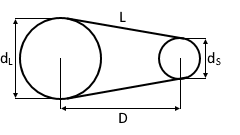Calculate Belt Length
Calculator and formulas for calculating the belt length of a drive
Belt Length Calculator
Calculate belt drive
Calculates the belt length of a drive with two pulleys or the center distance when the belt length is given.

Applications
Practical Applications
Belt Types
- V-belt: V-shaped cross-section
- Flat belt: Rectangular cross-section
- Timing belt: With teeth
- Round belt: Circular cross-section
- Poly belt: Multi-V belt
- Timing belt: Synchronous belt
|
|
Formulas for belt length
The belt length is calculated from the geometry of the two pulleys and their distance. The exact formula considers both the straight sections and the wrap angles.
Exact belt length formula
Precise calculation for any pulley diameters and center distances.
Approximate formula
Simplified calculation for similar pulley diameters.
Calculate center distance
Inverse calculation for center distance with given belt length.
Symbols and Units
- L = Belt length
- d₁ = Diameter of large pulley
- d₂ = Diameter of small pulley
- D = Center distance (center to center)
- Units: All measurements in same unit
- Note: Use diameters, not radii
Example: V-belt drive
Problem:
A V-belt drive has a driving pulley with 150 mm diameter and a driven pulley with 300 mm diameter. The center distance is 600 mm. What belt length is required?
Given:
- Diameter Pulley 1: d₁ = 150 mm
- Diameter Pulley 2: d₂ = 300 mm
- Center distance: D = 600 mm
- Find: Belt length L
Solution:
Detailed description of belt length calculation
Physical Fundamentals
This function calculates the belt length of a drive with two pulleys or the center distance when the belt length is given.
Usage Instructions
To calculate, select with the radio buttons whether the belt length or center distance should be calculated. Then enter the required values and click the 'Calculate' button. Diameters, distances and length have the same unit (e.g. meters or cm).
Application Areas
Mechanical Engineering
V-belts, flat belts, timing belts, industrial drives. Dimensioning of belt drives and transmission systems.
Automotive Engineering
Engine belts, auxiliary drive belts, alternator, water pump. Calculation of belt lengths for vehicle engines.
Conveyor Technology
Conveyor belts, transport belts, belt drives. Design of conveyor systems and transport systems.
Understanding Belt Drives
A belt drive transmits torque through friction between belt and pulleys. The geometry determines the required belt length:
Straight Sections
Run 1: Upper straight part
Run 2: Lower straight part
Length: 2 × tangent length
Calculation: Geometric
Wrap Angles
Large pulley: Partial arc
Small pulley: Larger arc
Sum: < Full circle
Calculation: Trigonometric
Total Length
L = Straight parts + Arcs
Exact: Arcsin formula
Approximate: For similar diameters
Application: Depends on accuracy
Important: The exact formula works well for all pulley ratios. The approximate formula fails for large diameter differences and small center distances.
|
|
|
|